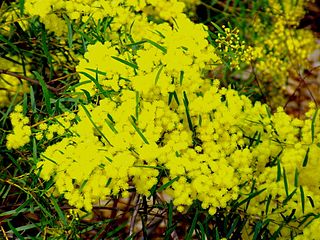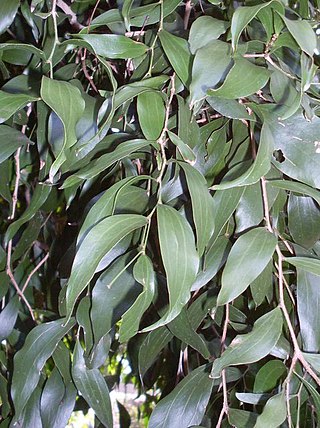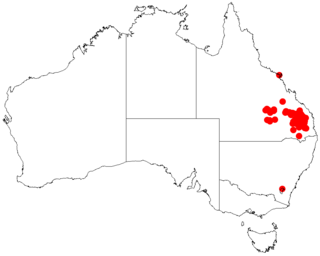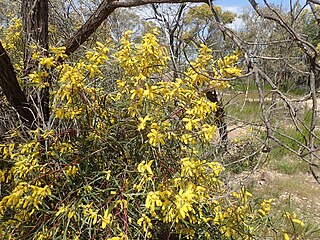
Acacia fimbriata, commonly known as the fringed wattle, Brisbane golden wattle, or just the Brisbane wattle, is a species of Acacia that is native to much of the east coast of Australia. It is one of the floral emblems of the city of Brisbane, Queensland.

Acacia bakeri, known as the marblewood, white marblewood, Baker's wattle or scrub wattle, is one of the largest of all acacias, growing to 40 m (130 ft) tall. It is a long-lived climax rainforest tree from eastern Australia. Unlike most acacias, fire is not required for seed germination. This tree is considered vulnerable to extinction. Its former habitat is lowland sub tropical rainforest which has been mostly cleared in the 19th and 20th centuries.

Acacia concurrens, commonly known as curracabah or black wattle, is a shrub native to Queensland in eastern Australia.

Acacia flexifolia, commonly known as bent-leaf wattle or small winter wattle, is a shrub species that is endemic to eastern Australia.

Acacia caesiella, commonly known as tableland wattle, bluebush wattle or blue bush, is a shrub or small tree that is endemic to eastern Australia.

Acacia jibberdingensis, also known as Jibberding wattle or willow-leafed wattle, is a shrub or tree belonging to the genus Acacia and the subgenus Juliflorae that is endemic to Western Australia.

Acacia symonii, also known commonly as Symon's wattle, is a tree or shrub belonging to the genus Acacia and the subgenus Juliflorae that is endemic to parts of arid central Australia.

Acacia veronica, commonly known as Veronica's wattle, is a shrub or tree of the genus Acacia and the subgenus Plurinerves that is endemic to a small area of south western Australia.

Acacia conferta, commonly known as crowded-leaf wattle, is a shrub belonging to the genus Acacia and the subgenus Phyllodineae that is endemic to eastern Australia.

Acacia costiniana, commonly known as Costin's wattle, is a shrub belonging to the genus Acacia and the subgenus Phyllodineae that is endemic to eastern Australia.

Acacia cretacea, also known as chalky wattle, is a shrub belonging to the genus Acacia and the subgenus Phyllodineae that is endemic to South Australia.

Acacia hamiltoniana, commonly known as Hamilton's wattle, is a shrub belonging to the genus Acacia and the subgenus Phyllodineae that is native to parts of eastern Australia.

Acacia pedina is a tree or shrub belonging to the genus Acacia and the subgenus Phyllodineae native to eastern Australia.

Acacia pustula is a tree belonging to the genus Acacia and the subgenus Phyllodineae native to north eastern Australia.

Acacia siculiformis, commonly known as dagger wattle, is a shrub belonging to the genus Acacia and the subgenus Phyllodineae native to south eastern Australia.

Acacia mabellae, commonly known as Mabels's wattle or black wattle, is a shrub or tree of the genus Acacia and the subgenus Phyllodineae that is endemic to eastern Australia.

Acacia doratoxylon, commonly known as currawang, lancewood, spearwood or coast myall, is a shrub or tree belonging to the genus Acacia and the subgenus Juliflorae that is native to eastern and south eastern Australia.

Acacia leptostachya, commonly known as Townsville wattle or slender wattle, is a shrub or small tree belonging to the genus Acacia and the subgenus Juliflorae that is native to north eastern Australia.

Acacia barattensis, commonly known as Baratta wattle, is a shrub of the genus Acacia and the subgenus Plurinerves that is endemic to a small area in South Australia where the species is considered to be rare.

Acacia elongata, also known as swamp wattle or slender wattle, is a shrub of the genus Acacia and the subgenus Plurinerves that is endemic to coastal areas of eastern Australia.





















